第二讲 翻译
第二讲:翻译的过程与策略解析
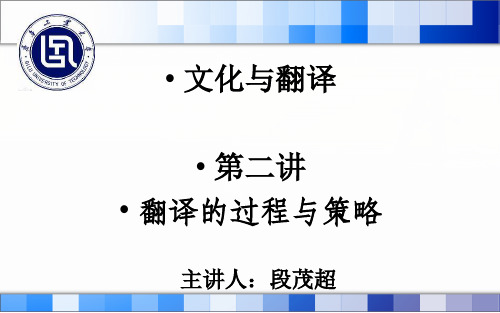
Examples:
• ① A:How often do you eat here, David? B:I eat here a lot. 应译为:“你多久来这吃一次啊,大卫 ?我经常来这吃。”如果把 “a lot”直译为“许多 ”或“很多很多”,这句话就不通顺了。 • ② A: All his geese are swans.? B: John is really such a person.应译为:“他老是言过其实么?约翰 就是这样一个人”。如果译成“他养的鹅都是天 鹅。”,那听上去就会莫名其妙了。 • ③ It is an ill bird that fouls its own nest. 家丑不可 外扬。
• ×管理人员面对的是商界前所未有的种种 现实,诸如就业的模式不断变化 包括外购 。重组等现象的猛增。 【译文】 管理人员面对的是商界前所未有 的种种现实,诸如企业用工方式的不断变 化 包括大幅度增加外部采办和新建联产单 位
• (2). 语言与周围经验世界的关系 • Were it left to an American to decide whether they should have a government without newspapers or newspapers without a government,he should not hesitate a moment to prefer the latter.
• 直译
• • • • • • • • A life line The Trojan horse The domino theory Dollar diplomacy A wolf in sheep’s clothing A trump card An ivory tower Man proposes, God disposes
商务英语翻译(第二讲)

investment in the infrastructure industry will not (at least in the short term) bring high economic
benefits.③ It is imperative to orient the investment to enterprises with better economic benefits, but
ห้องสมุดไป่ตู้
• 如果一方违反任何其根据第18.1条所作的陈述或担保,则另一方除 根据本合同或使用法律寻求任何可能的其他救济之外,违约方应当 赔偿另一方或合营公司因此种违约行为而招致的任何损失、损害、 费用、开支、责任或索赔。
• (分析:英语合同文本中的长句首先要仔细分析句子的内部结构, 判断句子是简单句、并列句、复合句,还是并列复合句。其次是找 出句中的主要成分,即主语和谓语动词。)
• 例2: Online culture thinks highly of the notion that the information flowing onto the screen come there by specific request.
• 在线文化赞赏这样的主张:不经用户特别请求,别把广告发到用户 的屏幕上。
• 例: Monetarists, led by University of Chicago Professor Emeritus Friedman armed themselves with evidence showing that free markets on their own produce as much growth and employment as an economy can sustain.
第二讲翻译学的基本概念

• 宁信而不顺(鲁迅语) rather to be faithful than smooth (“I’d rather be faithful than smooth”) • 神似(傅雷语) spiritual resemblance • 化境(钱钟书语)sublimation(升华) • 信、达、切(刘重德语)faithfulness, expressiveness and closeness (to the original style) • 三美: 音美, 形美, 意美(许渊冲语)the three beauties: beauty in sound, beauty in form and bea• •
选词diction 补偿compensation 视点转换shift of perspective 套译/仿译/仿拟imitation 信/忠实faithfulness/ 达/易懂intelligibility/expressiveness 通顺smoothness 流畅fluency 自然naturalness /idiomaticity(语言的表达习惯) 雅/优美elegance/gracefulness
• • • • • • • • •
东方语言Oriental languages 西方语言Occidental languages 佛经Buddhist Scriptures/sutra['su:trə] 梵语Sanskrit 鸠摩罗什Kumarajiva 泰特勒(Alexander Fraser )Tytler 奈达(Eugene A.) Nida 机器翻译machine translation(MT) 人工智能artificial intelligence(AI)
注意:英译汉中长句化短即采用分译法的 依据是:英语多用长句,汉语多用中短 句。长句化短要根据翻译实际需要为转 移。
第二讲:词汇翻译(上)

词汇翻译技巧 3.介词增减:英译汉时很多介词可以省略, 3.介词增减:英译汉时很多介词可以省略,汉译英时 介词增减
则需根据英语的行文需要增加适当的介词。 则需根据英语的行文需要增加适当的介词。
1)She was one of my colleagues at the ) university at which I taught. 她是我任教的那所大学的同事。 她是我任教的那所大学的同事。 2)I get positively angry with the ) impertinence of it and the everlastingness. 这么卤莽无礼,没完没了,真让我生气。 这么卤莽无礼,没完没了,真让我生气。 3)他已经把这事忘得一干二净了。 )他已经把这事忘得一干二净了。 He has forgotten all about it. 4)接到信时我高兴得跳了起来。 )接到信时我高兴得跳了起来。 I jumped with joy when I received the letter.
词汇翻译技巧 移植法 直接移植:在译文中将原文的词语原封不动地 直接移植: 挪用过来。如“卡拉 厅”、KTV包房 、“BP 挪用过来。 卡拉OK厅 、 包房”、 卡拉 包房 唱盘”、 光片 光片”、 发了一份 发了一份e-mail”、 机”、“CD唱盘 、“X光片 、“发了一份 、 唱盘 、 “进入 进入WTO”、“Word文件”、“如何执行 进入 、 文 、 如何执行 Windows 2000的应用程序”、“股票ABC”、 2000的应用程序 的应用程序”、“股票 股票ABC”、 NBA、CIA、IBM、IQ、EQ等等,汉语短语或句 等等, 、 、 、 、 等等 子中夹杂的这些英语单词就是直接移植过来的。 子中夹杂的这些英语单词就是直接移植过来的。 直接移植似乎多应用于科技翻译和新闻媒体 文学翻译则少见。 中,文学翻译则少见。
英汉互译第二讲

2.2 中英思维方式对比
2.2.1中国人注重伦理(ethics);英美人注重认 知(cognition)
“以儒家为代表的先哲对世界的认识主要不是出于对自然 奥秘的好奇,而是出于对现实政治和伦理道德的关注”。 儒家思想“关心的是人道,而非天道,是人生之理,而非 自然之性”。 而海洋性地理环境中发展起来的英美文化促使英美人对天 文地理的浓厚兴趣,使他们形成了探求自然的奥秘,向自 然索取的认知传统。
依据不同的标准,文化分类也林林总总。 从地域分,有本土文化和外来文化、城市文化和农村文化、东方文化和 西方文化、大陆汉文化和港澳台汉文化等; 从时间分,由原始文化、奴隶制文化、封建文化、资本化、道教文化、基督教文化、伊斯兰教文化等; 从生产方式分,有游牧文化、农业文化、工业文化、信息文化等; 从生产工具分,有旧石器文化、新石器文化、青铜文化; 从人类把握世界的方式分,有科学文化和人文文化; 从性质分,有世界文化、民族文化、精英文化、通俗文化等; 从结构层次分,有物质文化、制度文化、精神文化等。
二、习俗的差异 汉英习俗的差异是多方面的。如对狗的态度:狗在汉语文 化中是一种卑微的动物,与狗相关得表达一般含有贬义, 如“走狗、狗腿子、狗东西、癞皮狗、狗急跳墙、狗仗人势、 狗眼看人低、狼心狗肺”等。 英语文化中人们则欣赏狗的勇敢和忠诚, 如“a lucky dog(幸运儿)”、“Love me, love my dog(爱屋及 乌)”、“Every dog has his day(凡人皆有得意日)”等。 又如颜色方面,中国人喜爱红色,认为它代表热情、喜悦 和兴旺。传统中国婚礼上新娘子总是红色的奇葩,以示吉利; 新房也必由大红“喜”字 但英美文化中红色常与暴力、流血和战争有关。 因而为避免读者误解,著名翻译家David Hawkes不但把 《红楼梦》翻译成“The story of the stone”,还将全书的 “红”字都译为“green”。同样的差异还体现在白色、绿色 等颜色上。
重要的翻译理论
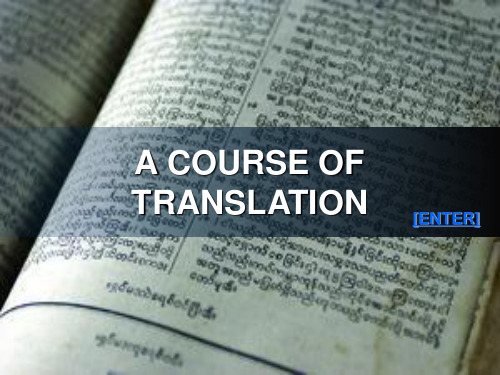
第十五讲 Metaphor的翻译
一、教学目的:了解和掌握修辞的翻译方法。 二、教学过程:
1. Metaphor 的界定与概念 2. Metaphor 的翻译原则与译法 3. 翻译段落练习
第一讲
翻译原则简介
第一讲
翻译原则简介
[<]
Hale Waihona Puke [1][2][3][4]第一讲
翻译原则简介
[<]
“The receptors of the translated text could respond to it with comprehension and appreciation in essentially the same manner and to the same degree as the original receptors of the message”; “Translation should arouse the same feeling in its receptors as the feeling of the readers of the original”---- Nida For instance: as white as snow 通常译为白如 雪 / 但没有见过雪的人可以将其翻译为“白 如白鹭毛”,以达到功能对等的目的。 Spring up like mushrooms---雨后春笋 Everybody's business is nobody's business. [1][2][3][4] 三
严 复 : 信 达 雅 — faithfulness/expressiveness/elegance. The “three character guide” is regarded as a plumb-line of long standing to measure the professional level of translating. 傅 雷 : 神 似 —spiritual conformity, Emphasizing the reproduction of the spirit of the flavor of the original. 强调原作神韵 再现。
第二讲 中西方翻译简史

教学目标
1.让学生了解中西方基本翻译理论。
2.让学生了解中西方翻译理论的发展现状。
3.讲评翻译作业、做翻译课堂练习。
教学重点、难点
1.中国翻译家的翻译理论与翻译观点。 2.西方翻译家的翻译理论与翻译观点。
• 佛经翻译须合乎原文本意,主张“尽从实录,按
本而传,不令有损言游字”,明确提出了“敬顺
圣言,了不加饰”的直译原则,主张严格的直译。
鸠摩罗什VS真谛VS彦琮 提倡意译,主张在存真的原则指导下,不妨“依 实出华”,讲究译文的流畅华美,因此他所译的 佛经都富于文学趣味,一直受到中国佛教徒和文 学爱好者的广泛传诵。他虽然倾向意译,但在实 践上基本仍然是折中而非偏激的。 • 真谛三藏到中国后20余年适逢兵乱,于颠沛流离 中仍能译出一百多部重要经论,是鸠摩罗什以后 玄奘以前贡献最大的译师。
and 2.5 billion more lack basic sanitation. If the status
quo continues, by the year 2025, half of the world’s
population, around 3 billion people will be living under water-stressed conditions, causing an increase in hunger, disease, preventable death and strife.
• 主要观点: • 译者应该像演说家一样,使用符合古罗马语言习 惯的语言来表达外来作品的内容。 • 直译是缺乏技巧的表现。翻译应保留词语最内层 的东西,即意思。 • 翻译也是文学创作。 • 各种语言的修辞手段彼此相通,因此翻译可以做 到风格对等。 • 提出“解释员”式翻译和“演说家”式翻译,即 直译与意译。
第二讲 翻译历史概述

翻译历史概述
2011-03-13
History is the memory of things said and done. Carl L. Becker 历史是一面镜子,也是一本深刻的教科书。 廖沫沙
Hale Waihona Puke 一、西方翻译史概述1、公元前3世纪中叶,罗马对希腊古典作品的译介 2、4-6世纪(罗马帝国后期至中世纪初期),《圣经》翻 译 3、9-10世纪,叙利亚学者用阿拉伯文翻译希腊典籍 3、11-13世纪(中世纪中期),西班牙托莱多的转译活动 4、14-16世纪(文艺复兴时期),翻译作品涉及各个领域, 产生大批杰出译家译作 5、17世纪下半叶至20世纪上半叶,继续翻译古典译作,开 始对西方近当代作品以及东方文学的翻译 6、1945年至今(二战以后至今),翻译从范围、规模、作 用直至形式,都与过去发生了很大的变化,机器翻译 出现。
汉英对照词汇表
佛经 Buddhist scriptures 佛经翻译 Buddhistic translation 音译 transliterate, transliteration 意译 free translation, liberal translation, paraphrase 译场 workshops for translation 梵文 Sanskrit 四书 Sishu, Ssu shu, the Four Books 五经 Wujing, the Five Classics 儒家学说 Confucianism 信达雅 faithfulness, expressiveness and elegance 马列著作 Marx and Lenin‘s Works,works of Marxism-Leninism 《毛泽东选集》Selected Works of Mao Zedong
第二讲 A Psalm of Life翻译鉴赏

第二讲 A Psalm of Life鉴赏·相关背景·亨利·沃兹渥斯·朗费罗,1807-1882,美国诗人。
《人生礼赞》这首诗写于1838年,很快成为一首极富盛名的诗篇。
此诗长达9节,以四步抑扬格写成。
它是一首训教诗,哲理深刻,作者感叹生活的艰辛,劝勉人们要坚韧不拔,不要气馁,要振作,要奋斗,要有所追求,要有所作为,从而使人生的小舟在经过风暴的洗礼之后抵达理想的彼岸。
《人生礼赞》这首诗自发表以来一直广为传诵,直到2000年还被当年的美国桂冠诗人与他人经广泛调查后选定,编入《美国人喜爱的诗》。
本诗还是第一首被译为汉语的欧美诗歌,最早的译文距今已一百多年,赢得了无数中国读者的心。
"A Psalm of Life" is a poem written by American writer Henry Wadsworth Longfellow and was published in October of 1838. It is a poem of encouragement, telling the reader not to waste life. Longfellow is sure to establish that life is real, and it will end soon. He wrote this poem at a fairly young age, yet he has a deep and accurate insight of life.The content of the poem is not especially unique. The speaker is involved in the first person perspective, where he is directly addressing the reader. The tone is neither positive nor negative, but is strictly honest. The tone remains the same "encouraging" style from beginning to end, and there is no change of tone. The only tension found in the poem is that between life and death - Longfellow writes about how every living thing is affected by both conflicting states of being.The word choice in "A Psalm of Life" was obviously carefully picked. An adjective is never repeated, yet the poem reads perfectly. Each word has its own meaning, and its own unique take on life, and every word adds something important, even vital, to the "life" of the poem. The rhythm also flows flawlessly. The rhythm scheme is an eight syllable line followed by a seven syllable line. The poem does not stray from that simple rhythm once.Imagery is the sole method of expression in the poem. Longfellow paints a word picture in each stanza that allows the reader to see more clearly what he is describing. Metaphors and Symbolism is rampant - in fact, the poem is almost entirely comprised of these things.The form of the poem is very basic. Each stanza is four lines long, making the poem a quatrain, and the rhyme scheme follows the pattern "ABAB, CDCD, EFEF..." etc. for each of the nine stanzas. Each stanza also has a recurrent rhythm pattern: 8 syllables, 7 syllables, 8 syllables, 7 syllables. Analyzing the poem even deeper, you will notice that even the punctuation plays an important role. Exclamation points are used to establish emphasis on a particular line. There is no pattern to the punctuation, which makes it even more beneficial to strengthening the meaning of a phrase. Overall, it is very obvious that "A Psalm of Life" is a well thought out poem.词语注解:Psalm:The Book of Psalms, commonly referred to simply as Psalms, is a book of the Hebrew Bible and the Christian Bible. Taken together, its 150 poems express virtually the full range of Israel'sreligious faith. 《诗篇》(《圣经·旧约》中的一卷。
易经全文及白话翻译
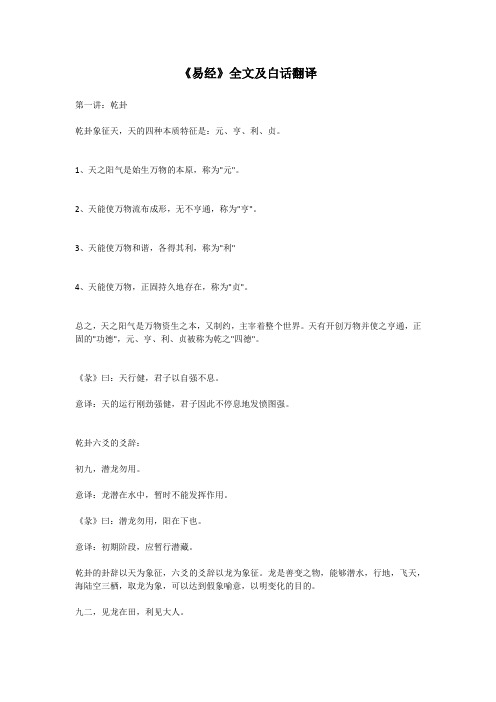
《易经》全文及白话翻译第一讲:乾卦乾卦象征天,天的四种本质特征是:元、亨、利、贞。
1、天之阳气是始生万物的本原,称为"元"。
2、天能使万物流布成形,无不亨通,称为"亨"。
3、天能使万物和谐,各得其利,称为"利"4、天能使万物,正固持久地存在,称为"贞"。
总之,天之阳气是万物资生之本,又制约,主宰着整个世界。
天有开创万物并使之亨通,正固的"功德",元、亨、利、贞被称为乾之"四德"。
《彖》曰:天行健,君子以自强不息。
意译:天的运行刚劲强健,君子因此不停息地发愤图强。
乾卦六爻的爻辞:初九,潜龙勿用。
意译:龙潜在水中,暂时不能发挥作用。
《彖》曰:潜龙勿用,阳在下也。
意译:初期阶段,应暂行潜藏。
乾卦的卦辞以天为象征,六爻的爻辞以龙为象征。
龙是善变之物,能够潜水,行地,飞天,海陆空三栖,取龙为象,可以达到假象喻意,以明变化的目的。
九二,见龙在田,利见大人。
意译:龙出现在田间,有利于大德大才之人出现。
九三,君子终日乾乾,夕惕若,厉无咎。
乾乾:健行不息。
若:语助词。
厉:危险。
意译:君子整天勤奋不息,甚至夜间时时警惕,虽然面临危险也无祸害。
九四,或跃在渊,无咎。
意译:相机而动,跃起上进,无咎害。
九五,飞龙在天,利见大人。
意译:飞龙上天,有利大德大才之人出现。
九五在所有卦里都是最吉之爻,此爻为"君位"。
皇帝通称"九五之尊",就是这么来的。
乾卦九五,刚健中正,纯粹而精,最为可贵。
上九,亢龙有悔。
意译:龙高飞到了极点,必有过悔。
用九,见群龙无首,吉。
意译:出现一群龙,都不以首领自居,吉祥。
常用占断用语:1、亨:通达,顺利。
2、利:有利,适宜。
3、吝:遗憾,麻烦,艰难。
4、厉:危险。
5、悔:忧虑,困厄。
6、咎:过错。
第二讲坤卦坤:元亨,利牝马之贞,君子有攸往,先迷,后得主,利。
第二讲语义翻译
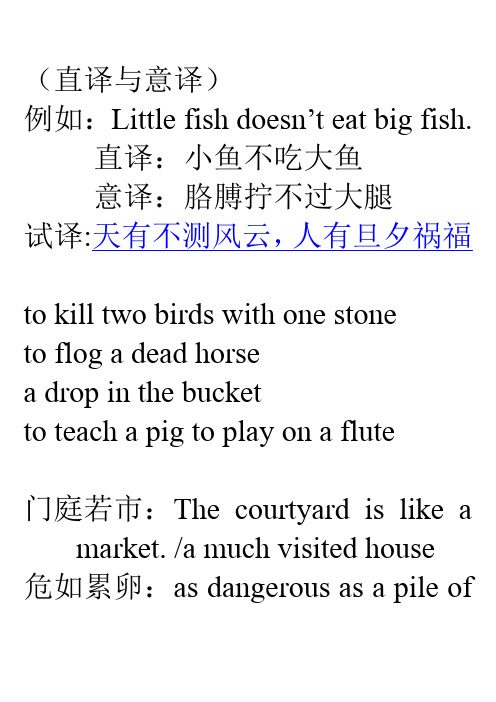
(直译与意译)例如:Little fish doesn’t eat big fish.直译:小鱼不吃大鱼意译:胳膊拧不过大腿试译:天有不测风云,人有旦夕祸福to kill two birds with one stoneto flog a dead horsea drop in the bucketto teach a pig to play on a flute门庭若市:The courtyard is like a market. /a much visited house危如累卵:as dangerous as a pile ofeggs/great insecurity; hazardousin the extreme由于文化对语言的影响,有些语言成分只能意译,而不能直译,这主要体现在受本国文化影响最深的成语和谚语上。
hand in glove with:和...狼狈为奸once in a blue moon: 千载难逢乱七八糟:at sixes and sevens (seven disorders and eight chaos)招风惹草:look for trouble (invite wind to exasperate the grass)It is an ill bird that fouls its own nest.外甥打灯笼---照舅(旧)归化与异化(domestication/adaptation orforeignization / alienation)归化的翻译在理论上是把语言看作交际工具;在实践上,强调通俗易懂,避免多义或歧义。
习惯认为,当原文与译文之间因文化差异而出现不能通达的情况时,“要用译语文化替代原语文化”即把在译语中找不到对等的外语词汇改头换面,或套用译语中与之相似的现成的表达法,把它们变成读者熟悉的译语文化形象。
归化派代表人物尤金•奈达(Eugene A. Nida): Functional Equivalence 功能对等“The receptors of the translated text could respond to it with comprehension and appreciation in essentially the samemanner and to the same degree as the original receptors of the message”;“Translation should arouse the same feeling in its receptors as the feeling of the readers of the original”---- NidaFor instance: as white as snow 通常译为白如雪/ 但没有见过雪的人可以将其翻译为“白如白鹭毛”,以达到功能对等的目的。
英汉翻译第二讲讲义解析
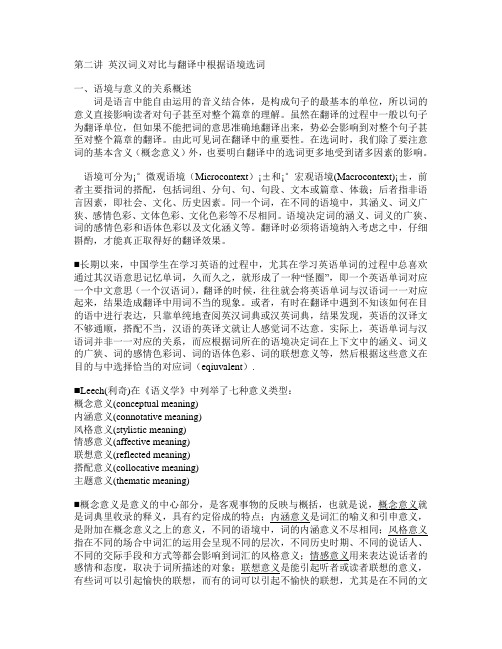
第二讲英汉词义对比与翻译中根据语境选词一、语境与意义的关系概述词是语言中能自由运用的音义结合体,是构成句子的最基本的单位,所以词的意义直接影响读者对句子甚至对整个篇章的理解。
虽然在翻译的过程中一般以句子为翻译单位,但如果不能把词的意思准确地翻译出来,势必会影响到对整个句子甚至对整个篇章的翻译。
由此可见词在翻译中的重要性。
在选词时,我们除了要注意词的基本含义(概念意义)外,也要明白翻译中的选词更多地受到诸多因素的影响。
语境可分为¡°微观语境(Microcontext)¡±和¡°宏观语境(Macrocontext)¡±,前者主要指词的搭配,包括词组、分句、句、句段、文本或篇章、体裁;后者指非语言因素,即社会、文化、历史因素。
同一个词,在不同的语境中,其涵义、词义广狭、感情色彩、文体色彩、文化色彩等不尽相同。
语境决定词的涵义、词义的广狭、词的感情色彩和语体色彩以及文化涵义等。
翻译时必须将语境纳入考虑之中,仔细斟酌,才能真正取得好的翻译效果。
⏹长期以来,中国学生在学习英语的过程中,尤其在学习英语单词的过程中总喜欢通过其汉语意思记忆单词,久而久之,就形成了一种“怪圈”,即一个英语单词对应一个中文意思(一个汉语词),翻译的时候,往往就会将英语单词与汉语词一一对应起来,结果造成翻译中用词不当的现象。
或者,有时在翻译中遇到不知该如何在目的语中进行表达,只靠单纯地查阅英汉词典或汉英词典,结果发现,英语的汉译文不够通顺,搭配不当,汉语的英译文就让人感觉词不达意。
实际上,英语单词与汉语词并非一一对应的关系,而应根据词所在的语境决定词在上下文中的涵义、词义的广狭、词的感情色彩词、词的语体色彩、词的联想意义等,然后根据这些意义在目的与中选择恰当的对应词(eqiuvalent).⏹Leech(利奇)在《语义学》中列举了七种意义类型:概念意义(conceptual meaning)内涵意义(connotative meaning)风格意义(stylistic meaning)情感意义(affective meaning)联想意义(reflected meaning)搭配意义(collocative meaning)主题意义(thematic meaning)⏹概念意义是意义的中心部分,是客观事物的反映与概括,也就是说,概念意义就是词典里收录的释义,具有约定俗成的特点;内涵意义是词汇的喻义和引申意义,是附加在概念意义之上的意义,不同的语境中,词的内涵意义不尽相同;风格意义指在不同的场合中词汇的运用会呈现不同的层次,不同历史时期、不同的说话人、不同的交际手段和方式等都会影响到词汇的风格意义;情感意义用来表达说话者的感情和态度,取决于词所描述的对象;联想意义是能引起听者或读者联想的意义,有些词可以引起愉快的联想,而有的词可以引起不愉快的联想,尤其是在不同的文化中,词的联想意义有很大的区别。
翻译第二讲分合译法(2)
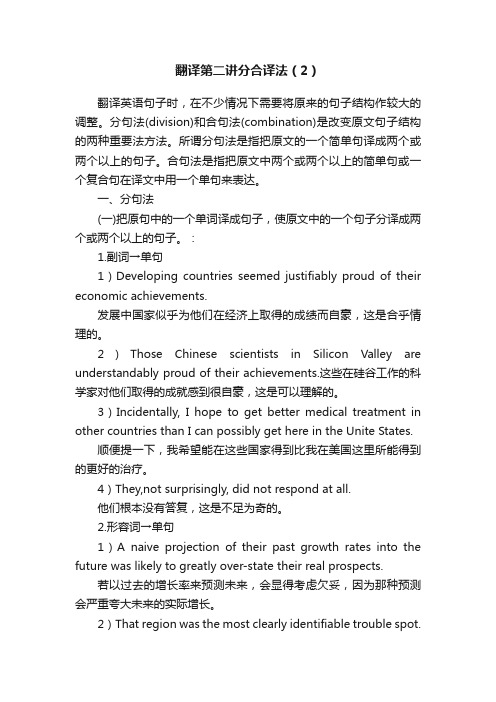
翻译第二讲分合译法(2)翻译英语句子时,在不少情况下需要将原来的句子结构作较大的调整。
分句法(division)和合句法(combination)是改变原文句子结构的两种重要法方法。
所谓分句法是指把原文的一个简单句译成两个或两个以上的句子。
合句法是指把原文中两个或两个以上的简单句或一个复合句在译文中用一个单句来表达。
一、分句法(一)把原句中的一个单词译成句子,使原文中的一个句子分译成两个或两个以上的句子。
:1.副词→单句1)Developing countries seemed justifiably proud of their economic achievements.发展中国家似乎为他们在经济上取得的成绩而自豪,这是合乎情理的。
2)Those Chinese scientists in Silicon Valley are understandably proud of their achievements.这些在硅谷工作的科学家对他们取得的成就感到很自豪,这是可以理解的。
3)Incidentally, I hope to get better medical treatment in other countries than I can possibly get here in the Unite States.顺便提一下,我希望能在这些国家得到比我在美国这里所能得到的更好的治疗。
4)They,not surprisingly, did not respond at all.他们根本没有答复,这是不足为奇的。
2.形容词→单句1)A naive projection of their past growth rates into the future was likely to greatly over-state their real prospects.若以过去的增长率来预测未来,会显得考虑欠妥,因为那种预测会严重夸大未来的实际增长。
第二讲《唐雎不辱使命》翻译
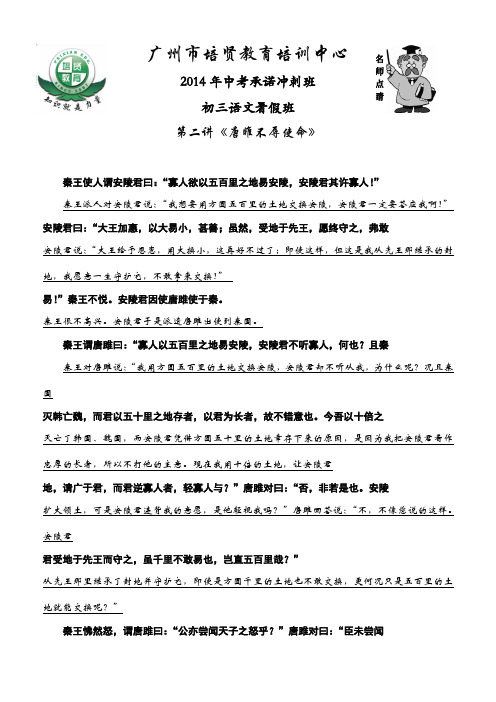
广州市培贤教育培训中心2014年中考承诺冲刺班初三语文暑假班第二讲《唐雎不辱使命》秦王使人谓安陵君曰:“寡人欲以五百里之地易安陵,安陵君其许寡人!” 秦王派人对安陵君说:“我想要用方圆五百里的土地交换安陵,安陵君一定要答应我啊!” 安陵君曰:“大王加惠,以大易小,甚善;虽然,受地于先王,愿终守之,弗敢 安陵君说:“大王给予恩惠,用大换小,这再好不过了;即使这样,但这是我从先王那继承的封地,我愿意一生守护它,不敢拿来交换!”易!”秦王不悦。
安陵君因使唐雎使于秦。
秦王很不高兴。
安陵君于是派遣唐雎出使到秦国。
秦王谓唐雎曰:“寡人以五百里之地易安陵,安陵君不听寡人,何也?且秦秦王对唐雎说:“我用方圆五百里的土地交换安陵,安陵君却不听从我,为什么呢?况且秦国灭韩亡魏,而君以五十里之地存者,以君为长者,故不错意也。
今吾以十倍之灭亡了韩国、魏国,而安陵君凭借方圆五十里的土地幸存下来的原因,是因为我把安陵君看作忠厚的长者,所以不打他的主意。
现在我用十倍的土地,让安陵君地,请广于君,而君逆寡人者,轻寡人与?”唐雎对曰:“否,非若是也。
安陵扩大领土,可是安陵君违背我的意愿,是他轻视我吗?”唐雎回答说:“不,不像您说的这样。
安陵君君受地于先王而守之,虽千里不敢易也,岂直五百里哉?”从先王那里继承了封地并守护它,即使是方圆千里的土地也不敢交换,更何况只是五百里的土地就能交换呢?”秦王怫然怒,谓唐雎曰:“公亦尝闻天子之怒乎?”唐雎对曰:“臣未尝闻 名师点睛秦王勃然大怒,对唐雎说:“先生曾听说过天子发怒吗?”唐雎回答说:“我未曾听说过。
”也。
”秦王曰:“天子之怒,伏尸百万,流血千里。
”唐雎曰:“大王尝闻布衣之秦王说:“天子发怒的时候,倒下的尸体会有百万,血流千里。
”唐雎说:“大王曾经听说过平民发怒吗?”怒乎?”秦王曰:“布衣之怒,亦免冠徒跣,以头抢地耳。
”唐雎曰:“此庸夫之秦王说:“平民发怒,也不过就是摘掉帽子,光着脚,把头往地上撞罢了。
第二讲 翻译的标准
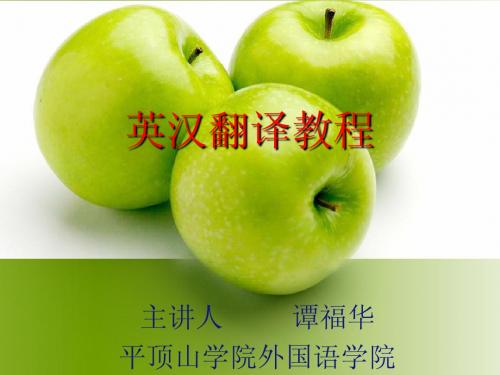
林语堂:忠实、通顺、和美 faithfulness, smoothness, beauty
刘重德:信、达、切 faithfulness, expressiveness and closeness
傅雷:传神论/神似说 Transference of soul or spirit “以效果而论,翻译应当像临画一样,所求的 不在形似而在神似。” 译文同原文在内容上一致,这叫“意似”,是 翻译的最低标准。译文同原文如果能在形式 上和精神上同时一致起来,或称“形似”和 “神似”,这是翻译的高标准。 理想的译文仿佛是原作者的(中文)写作。
For Nida, the success of the translation depends above all on achieving equivalent response. It is one of the „four basic requirements of a translation‟, which are: 1. Making sense 2. Conveying the spirit and the manner of the original; 3. having a natural and easy form or expression 4. Producing a similar response
4 翻译的标准
严复:信、达、雅 Faithfulness, expressiveness and elegance ⊙信:忠实于原文 ⊙达:文笔流畅 ⊙雅:文风典雅 (士大夫) --保持原文的风格
鲁迅:信和顺 “凡是翻译,必须兼顾着两面,一当然力求其 易解,一则保存原作的风姿。” 宁信而毋顺 rather be faithful in thought than smooth in language
第二讲当代翻译理论
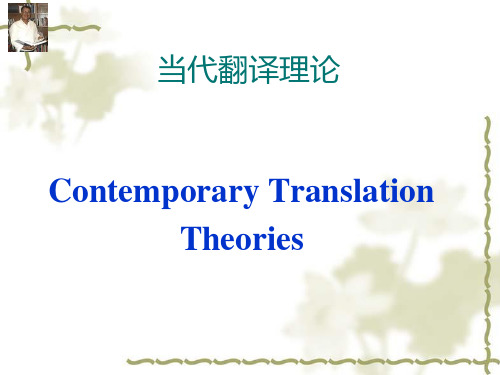
2.3 Horace
Horace argues for the revitalization of well-known texts through a style that would “neither linger in the one hackneyed and easy round; neither trouble to render word by word with the faithfulness of a translator”, not treat the original writer‟s beliefs with too easy a trust, and would avoid stylistic over-sensationalism, “ so that the middle never strikes a different note from the beginning, nor the end from the middle.” His criticism of the faithful translator is often turned on its head to support translational fidelity to the original.
3.4.1 John Dryden‟s Three Categories of Translation 3.5 Alexander Fraser Tytler ( 1747-1813) 3.5.1 Tytler‟s Three General Principles
4. Romanticism in Translation Studies
another language
第二讲直译意译
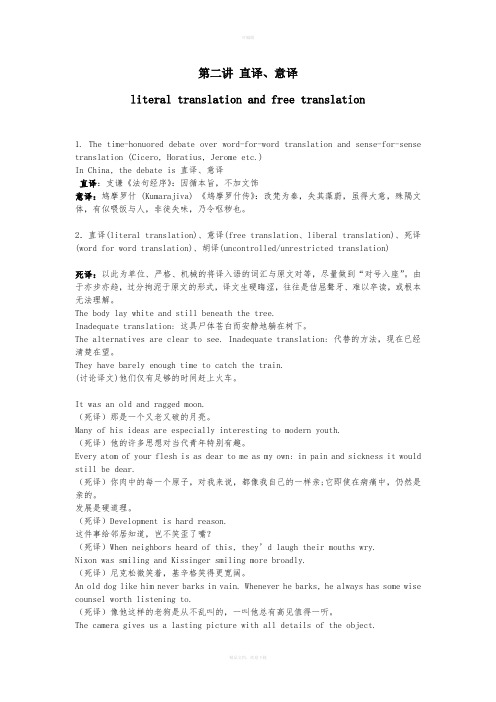
第二讲直译、意译literal translation and free translation1. The time-honuored debate over word-for-word translation and sense-for-sense translation (Cicero, Horatius, Jerome etc.)In China, the debate is 直译、意译直译:支谦《法句经序》:因循本旨,不加文饰意译:鸠摩罗什 (Kumarajiva) 《鸠摩罗什传》:改梵为秦,失其藻蔚,虽得大意,殊隔文体,有似喂饭与人,非徒失味,乃令呕秽也。
2.直译(literal translation)、意译(free translation、liberal translation)、死译(word for word translation)、胡译(uncontrolled/unrestricted translation)死译:以此为单位、严格、机械的将译入语的词汇与原文对等,尽量做到“对号入座”。
由于亦步亦趋,过分拘泥于原文的形式,译文生硬晦涩,往往是佶屈聱牙、难以卒读,或根本无法理解。
The body lay white and still beneath the tree.Inadequate translation: 这具尸体苍白而安静地躺在树下。
The alternatives are clear to see. Inadequate translation: 代替的方法,现在已经清楚在望。
They have barely enough time to catch the train.(讨论译文)他们仅有足够的时间赶上火车。
It was an old and ragged moon.(死译)那是一个又老又破的月亮。
Many of his ideas are especially interesting to modern youth.(死译)他的许多思想对当代青年特别有趣。
第二讲 翻译的定义与过程

(14)概括地说,翻译是一种跨文化 的信息交流与交往的活动,其本质就 是交往传播(communication)。 无论采用怎样的形式,如笔译、口译、 及机器翻译,也无论 所译的内容,如 科技信息、文学作品、应用文章,它 们所要完成的任务都可以归纳为信息 的传播与交流。(吕俊:建构主义的 视角)
“By Jove, she has taste!” exclaimed Henry Lynn. (Jane Eyre) “嗬,她还挑肥拣瘦呢!”亨 利· 利恩嚷道。
…and she is bursting with repletion; have the goodness to serve her as auditress and interlocutrece. (Jane Eyre) 她(指罗切斯特收养的女孩阿列 代)憋了一肚子的话,行个好, 去跟她唠叨唠叨,听听她说话吧。
(2)翻译的目的就是把一种语言中的内容 和形式移植到另一种语言中去。(前苏联: 索伯列夫) (3)翻译就是用一种语言把另一种语言在 内容与形式上不可分割的统一中所业已表达 出来的东西准确而完善地表达出来。(前苏 联:费道罗夫)
(4)翻译是把一种语言的言语产物,在保 持内容方面也就是意义不变的情况下,联:巴尔胡达罗夫)
But oh, Mr. Osborne, what a difference eighteen months’ experience makes. (Vanity Fair) 奥斯本先生,你不知道这一年半 里我学了多少乖。
She is just as rich as most of the girls who come out to India. I might go farther and fare worse, egad! (Vanity Fair) 跟那些出国到印度去的女孩子比 一比,她不见得穷到哪儿去。说 不定我左等右等,反而挑着个不 如她的。
- 1、下载文档前请自行甄别文档内容的完整性,平台不提供额外的编辑、内容补充、找答案等附加服务。
- 2、"仅部分预览"的文档,不可在线预览部分如存在完整性等问题,可反馈申请退款(可完整预览的文档不适用该条件!)。
- 3、如文档侵犯您的权益,请联系客服反馈,我们会尽快为您处理(人工客服工作时间:9:00-18:30)。
1. 词汇中的文化差异
反映中国文化特有的事物和现象的词语,如‚盘
古‛、‚女娲‛、‚秀才‛、‚八股文‛、‚太 极拳‛、‚个体户‛等,虽然在英语里找不到意 义完全对等的词语,却不是语义转换的主要障碍, 通过阐释或注解总有办法把它们的意思解释清楚 并传达出去,所以上述词语只能属于概念意义的 空缺,而不列入本章所讲的文化意义。 文化意义是指词语意义之外的、能产生联想的内 涵意义。具有这类双重意义的词语往往构成翻译 的主要障碍,因为它们常常兼指多意,甚至以内 涵意义为主。这样的词语,虽然在英语里能找到 概念相同的词语,却可能出现文化含义的不对应 或假对应。
like a fowl and then went on walloping and kicking him till his nose and mouth were a bloody pulp.
老王和我算是柳家大院最‚文明‛的人了。‚文明‛
是三孙子。(老舍《柳家大院》)
Old Wang and I are considered the genteel folk in the
10
狗(鄙视) 龙(高贵) 红(喜庆) 白(丧服) 蓝(纯净)
dog(同情) dragon(凶恶) red(暴力) white(婚妙) blue(忧郁、淫秽)
黄(王权)
牧童(悠闲) 月亮(团圆) 宣传(中性词)
yellow(怯懦)
cowboy(冒险) moon(虚幻) propaganda(贬义词)
4
宗教文化特色
周瑞家的听了笑道:‛阿弥陀佛,真坑死人的事儿!等十年
都未必这样巧的呢。‛ (曹雪芹《红楼梦》) 杨译:‚Gracious Buddha!‖ Mrs. Zhou chuckled. ―How terrible chancy! You might wait for ten years without such a run of luck.‖ 霍译:‚God bless my soul!‖ Zhou Rui‘s wife exclaimed. ―You would certainly need some patience! Why, you might wait ten years before getting all those things at the proper times.‖ 世人都晓神仙好,惟有功名忘不了!(曹雪芹《红楼梦》) 杨译:All men long to be immortals, yet to riches and rank each aspires; 霍译:Men all know that salvation should be won, but with ambition won‘t have done, have done.
Difference between Cultures
Allan Peng
1
Culture and language
Culture refers to the total pattern of beliefs, customs,
institutions, objects, and techniques that characterize the life of a human community.
11
农民(忠厚朴实) peasant(心胸狭窄)
1.1 概念意义与文化意义完全对应
直译
原文的概念意义和文
化意义、形象与寓意 同时传达到译文当中
12
丢脸
露面 老手
to lose face , face -losing
to show one 's face , …up an old hand
帮助译文读者跨越文化障碍
7
真是 ‘天有不测风云,人有旦夕祸福’。
杨 译 : ‚ Truly, ‗storm gathers without warning in
nature, and bad luck befalls men overnight.‘... ‖ 霍译:‚I know ‗the weather and human life are both unpredictable‘‖ 这也难说,但凡家庭之事,不是东风压了西风,就是 西风压了东风。 杨译:‚Well, it‘s hard to say,‖ she answered. ―In every family, if the east wind doesn‘t prevail over the west wind, then the west wind is bound to prevail over the east wind.‖ 霍译:‘It‘s hard to tell,‘ she said. ‗In every family affair, one side or the other has to win. If it‘s not the East Wind it‘s the West.‘
5
刘姥姥说‚这倒不然,谋事在人,成事在天。咱们
谋到了,看菩萨的保佑,有些机会也可知……‛
杨译:―Don‘t be so sure,‖ said Granny Liu. ―Man
proposes, Heaven disposes. Work out a plan, trust to Buddha, and something may come of it for all you know~~~‖ 霍译:―I wouldn‘t say that,‖ said Grannie Liu, ―Man proposes, God disposes. It‘s up to the good lord to decide whether he‘ll help us or not. Who knows, he might give us the opportunity we are looking for~~~‖
3. 语用方面的文化差异
3
中国是个大陆国家,幅员辽阔,地大物博
黔驴技穷 人心齐,泰山移 不到黄河心不死 不到长城非好汉 福如东海,寿比南山
地域文化特色
英国是一个岛国,历史上航海业比较发达,
反映在语言中就出现了许多与海洋、船和水 有关的短语。
all at sea(不知所措) burn one’s boats(破釜沉舟) sail before the wind(顺风航行) keep one’s head above water(奋力图存)
haven‘t yet drunk the bridal cup but already you‘re doing her hair.‖
文化是一种复杂体,它包括知识、信仰、艺术、道
德、法律、风俗, 以及其余社会上习得的能力与
习惯。
2
Difference between CulturLeabharlann s 1. 词汇中的文化差异
1.1 概念意义与文化意义完全对应
1.2 概念意义对应,文化意义空缺
1.3 概念意义对应,语用意义不同
2. 成语习语中的文化差异
He has long had a well-thought-out plan in his mind.
15
接着他们用绳子五花大绑,把节振国捆得象个粽子似
的,又是一阵拳打脚踢。节振国的嘴里鼻孔里鲜血直 冒。(王义《赤胆忠心》)
They gave him a good cuff and kick, trussed him up
6
文化特色在语言中的体现
文化因素的处理是翻译中十分重要的任务,
文化的载体改变了,文化的读者环境也不 复存在了,这时就会出现两种情形:
译入语没有相应的词语来承载源语种的文化因素,
形成词语空缺。 译文受众缺乏理解原文所需要的汉文化背景知识, 或者以自己的文化背景去理解译文,造成误解。
把握原文文字的文化含义 补充原文蕴含的文化背景 澄清异族文化中容易误解的概念
compound. Gentility be hanged! (Gentility be blowed! Gentility, the deuce take it !)
16
‚哦,交杯盏还没吃,倒上头了!‛
霍译:―Fancy! Doing
her hair already--before you‘ve even drunk the marriagecup!‖
8
他素昔眼空心大,是个头等刁钻古怪的丫头,今儿
我听了他的短儿,‚人急造反,狗急跳墙‛,不但 生事,而且我还没趣。(曹雪芹《红楼梦》) 杨译:She is a strange crafty creature if ever I saw one. ―Desperation drives men to rebel and a dog to jump over a wall.‖ If she thinks I know her secret there may be trouble, and that would be awkward for me. 霍 译 : If a girl like that knows that I have overheard her doing something she shouldn‘t be doing, it will be a case of ―the desperate dog will jump a wall, the desperate man will hazard all‖; there‘ll be a great deal of trouble and I shall be involved in it.
笑柄
碰壁 好心 祸不单行 趁热打铁
